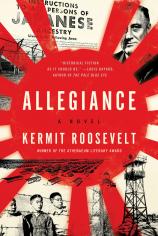Allegiance
Review
Allegiance
In 2005, law professor Kermit Roosevelt published his first work of fiction, IN THE SHADOW OF THE LAW, which won recognition as a Christian Science Monitor Best Book of the Year. It was a contemporary legal novel that took a somewhat jaundiced view of the world of large law firms. Following this success, Roosevelt ventured into other aspects of scholarly legal writing. He published a textbook on Conflict of Laws, as well as THE MYTH OF JUDICIAL ACTIVISM, a thoughtful discussion on the continuing debate between conservatives and liberals on the role of the Supreme Court in our legal system. Now Roosevelt has returned to his fictional roots with ALLEGIANCE, a novel combining legal themes and a traditional mystery in a historical context.
ALLEGIANCE begins on December 7, 1941. Caswell “Cash” Harrison is a third-year law student at Columbia. Upon hearing the news of the attack on Pearl Harbor, his initial inclination is to immediately enlist in the military. But he remains at Columbia, completes his final year of law school and waits to be drafted. Upon attending his physical, however, he is declared 4-F by a military doctor. Cash still wishes to serve his country in some fashion. Through family and law school contacts, he learns of a position as a Supreme Court clerk. Justice Hugo Black has had two of his preferred choices for clerk drafted; Cash becomes his clerk and tennis partner.
"...an enjoyable, thoughtful, informative and compelling novel that is certainly worth reading."
Having served as a clerk, albeit in different times, Roosevelt is aware of life in the Supreme Court. During the 1940s, the task of most clerks was to review certiorari petitions, requests for the Supreme Court to hear cases. Cash settles in the job, but something unsettling seems to be happening at the court. Clerks are being followed, and mysterious activity is unfolding. Cash and fellow clerk Gene Gressman (a character named by Roosevelt as a tribute to a noted Supreme Court scholar) seek to solve the mystery. But when Gene dies and his death is attributed to natural causes, Cash believes he was murdered.
As the mystery unfolds, there is a parallel plot centering on the issue of internment of Japanese-Americans in resettlement camps. In the novel, Roosevelt describes the issues surrounding this epic legal struggle. The gathering of facts, writing of briefs and oral arguments before the court are described in meticulous detail. Roosevelt’s knowledge of constitutional law and procedure, coupled with his use of actual transcripts, makes for informative reading. Issues in this debate still resonate in contemporary America.
Perhaps the most interesting aspect of ALLEGIANCE is its vivid portrayals of actual historical figures. Justice Hugo Black is still in his formative years as a young member of the court. Felix Frankfurter is the Justice whose arrogance alienates fellow Justices and hampers his ability to gain support for his legal views. Other appearances include J. Edgar Hoover and his assistant, Clyde Tolson, who are knee-deep in the investigation of what is happening at the Supreme Court; Attorney General Francis Biddle; and several notable non-political figures.
Roosevelt sometimes gets bogged down in minutiae and legal detail. As a lawyer, I found some of it interesting, though non-lawyers may consider these portions difficult to navigate. Overall, however, ALLEGIANCE is an enjoyable, thoughtful, informative and compelling novel that is certainly worth reading.
Reviewed by Stuart Shiffman on November 6, 2015
Allegiance
- Publication Date: August 25, 2015
- Genres: Fiction, Historical Fiction, Historical Thriller, Suspense, Thriller
- Hardcover: 400 pages
- Publisher: Regan Arts
- ISBN-10: 1941393306
- ISBN-13: 9781941393307




